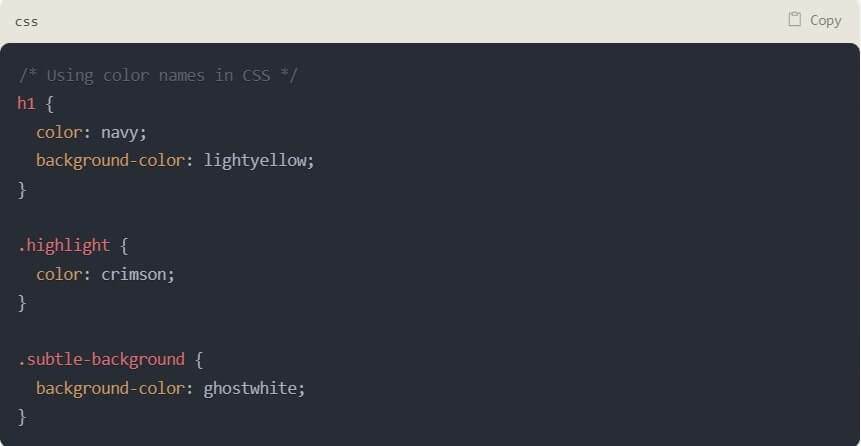What are W3C Color Names?
In the vast ocean of web development, colors play a crucial role in creating visually appealing websites. When developers need to specify colors, they have several options – hexadecimal codes, RGB values, HSL values, or the simpler W3C color names. But what exactly are these W3C color names, and why are they important?
Table of Contents
This article provides a comprehensive overview of W3C color names, explaining their purpose, the full list, and how they can be applied in web development.
What are W3C Color Names?
W3C Color Names are a predefined list of 147 colors that can be used in HTML and CSS by simply referencing their names. These names are recognized by all modern web browsers, ensuring consistency in web design. Instead of using hexadecimal or RGB values, developers can write color names directly, making the code more readable and user-friendly.
For example, instead of writing:
color: #FF0000;
you can simply write:
color: red;
Both will produce the same result—a red color for the text.
Full List of W3C Color Names
Below, you will find an exhaustive compilation of W3C color names.
| Color Name | Color Code | Color Name | Color Code |
| AliceBlue | F0F8FF | AntiqueWhite | FAEBD7 |
| Aqua | 00FFFF | Aquamarine | 7FFFD4 |
| Azure | F0FFFF | Beige | F5F5DC |
| Bisque | FFE4C4 | Black | 000000 |
| BlanchedAlmond | FFEBCD | Blue | 0000FF |
| Blueviolet | 8A2BE2 | Brown | A52A2A |
| BurlyWood | DEB887 | CadetBlue | 5F9EA0 |
| Chartreuse | 7FFF00 | Chocolate | D2691E |
| Coral | FF7F50 | CornflowerBlue | 6495ED |
| Cornsilk | FFF8DC | Crimson | DC143C |
| Cyan | 00FFFF | DarkBlue | 00008B |
| DarkCyan | 008B8B | DarkGlodenRod | B8860B |
| DarkGrey | A9A9A9 | DarkGray | A9A9A9 |
| DarkGreen | 006400 | DarkKhaki | BDB76B |
| DarkMagenta | 8B008B | DarkOliveGreen | 556B2F |
| DarkOrange | FF8C00 | DarkOrchid | 9932CC |
| DarkRed | 8B0000 | DarkSalmon | E9967A |
| DarkSeaGreen | 8FBC8F | DarkSlateBlue | 483D8B |
| DarkSlateGrey | 2F4F4F | DarkSlateGray | 2F4F4F |
| DarkTurquoise | 00CED1 | DarkViolet | 9400D3 |
| DeepPink | FF1493 | DeepSkyBlue | 00BFFF |
| DimGray | 696969 | DodgerBlue | 1E90FF |
| FireBrick | B22222 | FloralWhite | FFFAF0 |
| ForestGreen | 228B22 | Fuchsia | FF00FF |
| Gainsboro | DCDCDC | GhostWhite | F8F8FF |
| Gold | FFD700 | GoldenRod | DAA520 |
| Gray | 808080 | Grey | 808080 |
| Green | 008000 | GreenYellow | ADFF2F |
| HoneyDew | F0FFF0 | HotPink | FF69B4 |
| IndianRed | CD5C5C | Indigo | 4B0082 |
| Ivory | FFFFF0 | Khaki | F0E68C |
| Lavender | E6E6FA | LavenderBlush | FFF0F5 |
| LawnGreen | 7CFC00 | LemonChiffon | FFFACD |
| LightBlue | ADD8E6 | LightCoral | F08080 |
| LightCyan | E0FFFF | LightGoldenRodYellow | FAFAD2 |
| LightGray | D3D3D3 | LightGrey | D3D3D3 |
| LightGreen | 90EE90 | LightPink | FFB6C1 |
| LightSalmon | FFA07A | LightSeaGreen | 20B2AA |
| LightSkyBlue | 87CEFA | LightSlateGray | 778899 |
| LightSlateGrey | 778899 | LightSteelBlue | B0C4DE |
| LightYellow | FFFFE0 | Lime | 00FF00 |
| LimeGreen | 32CD32 | Linen | FAF0E6 |
| Magenta | FF00FF | Maroon | 800000 |
| MediumAquaMarine | 66CDAA | MediumBlue | 0000CD |
| MediumOrchid | BA55D3 | MediumPurple | 9370DB |
| MediumSeaGreen | 3CB371 | MediumSlateBlue | 7B68EE |
| MediumSpringGreen | 00FA9A | MediumTurquoise | 48D1CC |
| MediumVioletRed | C71585 | MidnightBlue | 191970 |
| MintCream | F5FFFA | MistyRose | FFE4E1 |
| Moccasin | FFE4B5 | NavajioWhite | FFDEAD |
| Navy | 000080 | OldLace | FDF5E6 |
| Olive | 808000 | OliveDrab | 6B8E23 |
| Orange | FFA500 | OrangeRed | FF4500 |
| Orchid | DA70D6 | PaleGoldenRod | EEE8AA |
| PaleGreen | 98FB98 | PaleTurquoise | AFEEEE |
| PaleVioletRed | DB7093 | PapayaWhip | FFEFD5 |
| PeachPuff | FFDAB9 | Peru | CD853F |
| Pink | FFC0CB | Plum | DDA0DD |
| PowderBlue | B0E0E6 | Purple | 800080 |
| RebeccaPurple | 663399 | Red | FF0000 |
| RostyBrown | BC8F8F | RoyalBlue | 4169E1 |
| SaddleBrown | 8B4513 | Salmon | FA8072 |
| SandyBrown | F4A460 | SeaGreen | 2E8B57 |
| SeaShell | FFF5EE | Sienna | A0522D |
| Silver | C0C0C0 | SkyBlue | 87CEEB |
| SlateBlue | 6A5ACD | SlateGray | 708090 |
| SlateGrey | 708090 | Snow | FFFAFA |
| SpringGreen | 00FF7F | SteelBlue | 4682B4 |
| Tan | D2B48C | Teal | 008080 |
| Thistle | D8BFD8 | Tomato | FF6347 |
| Turquoise | 40E0D0 | Violet | EE82EE |
| Wheat | F5DEB3 | White | FFFFFF |
| WhiteSmoke | F5F5F5 | Yellow | FFFF00 |
| YellowGreen | 9ACD32 | ||
How to Use W3C Color Names in Practice
Implementing named colors in web development is straightforward:

These color names can be used anywhere a color value is expected in CSS – for text colors, backgrounds, borders, and other properties.
Why Use W3C Color Names?
In a world where hexadecimal codes like #FF5733 or RGB values like rgb(255, 87, 51) offer precise color control, why would developers opt for named colors? There are several compelling reasons:
1. Readability and Maintenance
Color names make code more human-readable. When scanning CSS files, “forestgreen” immediately conveys meaning, while “#228B22” requires mental translation. This improves code maintainability, especially in large projects with multiple developers.
2. Semantic Meaning
Color names often carry semantic meaning that numeric values lack. When a designer specifies “skyblue” versus “lightblue,” the name itself communicates design intent. This semantic layer adds value during both development and maintenance phases.
3. Convenience for Prototyping
During the rapid prototyping phase, developers can quickly implement color schemes using familiar names without consulting color pickers or remembering hex codes. This speeds up the initial development process.
4. Accessibility Considerations
For developers with color vision deficiencies, named colors can be easier to work with than trying to visualize hex or RGB values. They provide an additional layer of accessibility within the development process itself.
Limitations of W3C Color Names
Despite their advantages, W3C color names have notable limitations:
Limited Palette
Even with 147 colors, the named color palette represents only a tiny fraction of the 16.7 million colors possible in the standard web color space. For precise brand colors or specific design requirements, developers often need to use hex or RGB values.
Subjective Interpretation
Color names can be subjective – what one person imagines as “tomato” might differ from the actual implemented color. This can lead to confusion when verbally discussing color choices.
Browser Compatibility Concerns
While the basic 16 colors have excellent cross-browser support, some of the extended color names might render slightly differently across browsers, particularly in older versions.
Alternative Color Formats in Web Development
For more precise color control, web developers often use:
- Hexadecimal (Hex) Codes – Example: #FF5733
- RGB (Red, Green, Blue) Values – Example: rgb(255, 87, 51)
- HSL (Hue, Saturation, Lightness) Values – Example: hsl(9, 100%, 64%)
Conclusion
W3C color names represent an important standardization effort that bridges the gap between human language and computer code. They offer a convenient, readable alternative to numeric color values for many web development scenarios.
While they may not provide the precision of hexadecimal or RGB values for every design situation, they deliver significant benefits in code readability, maintenance, and rapid development. Understanding these standardized color names and their appropriate use cases is an essential part of a web developer’s knowledge base.
Whether you’re a seasoned developer or just starting your journey in web design, familiarizing yourself with W3C color names provides you with a versatile tool for expressing color in your projects. In the colorful world of web development, these standardized names ensure we’re all speaking the same visual language.
READ NEXT:





